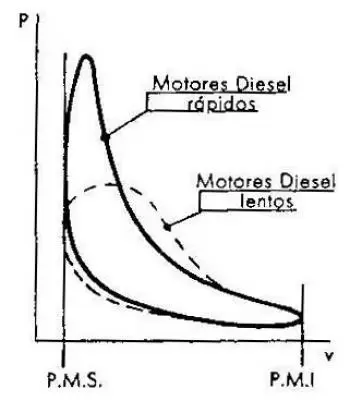
Between the real and theoretical diesel cycles there are differences and similarities in the form and in the values of the pressures and temperatures. Differences that also appear in the Otto cycle. Some of these similarities correspond to those of the Otto cycle; for example, the similarities due to the variation of the specific heats, to the loss of heat and to the opening time of the exhaust valve.
Others differ in part and are caused by dissociation and pump loss. Finally, one is peculiar to the diesel engine, namely; the one referring to the fact that combustion does not take place at constant pressure in the case of the real cycle.
What are the differences in the cycles of 4-stroke engines?
The actual and theoretical cycle differences between a compression-ignition diesel engine are slightly different from those of a two-stroke engine. We first analyze the differences in the four-stroke cycles.
To explain the differences between the real and theoretical cycle we enclose an indicated diagram of the diesel cycle applied in pressure ignition engines.
Constant pressure combustion
As can be seen in the diagram indicated, in practice the combustion takes place under such conditions that the pressure varies during the process, while in the theoretical cycle we had assumed that it remained constant.
Actually, part of the combustion takes place at constant volume, and part at constant pressure, almost like in the real Otto cycle. Only in the case of very slow engines does it develop slightly approximate to the theoretical process.
Dissociation of combustion products
In compression ignition engine, decoupling does not have as great an effect as in positive ignition engine (gasoline engine). So the excess air and the mixture of the combustion products are such that they reduce the maximum temperature. Consequently, this excess also reduces the dissociation of said products.
Pump loss
The pumping losses of a diesel engine are lower than those of an Otto cycle gasoline engine. This is because there is no constriction in the suction air. In compression ignition diesel engines there is no butterfly valve, characteristic of positive ignition engines, equipped with carburettors. Therefore, the negative surface of the real diesel cycle is less than that of the Otto cycle.
What are the differences in the cycles of 2-stroke engines?
The points analyzed above correspond to the four-stroke engine.
Two-stroke engines are quite widespread among diesel engines. In the two-stroke cycle, pumping loss and loss caused by stopping expansion before bottom dead center (PMI) to cause leakage are important.
Included in the pumping loss, the work necessary to carry out the flushing of the cylinder, which is often carried out by a compressor, must also be considered.